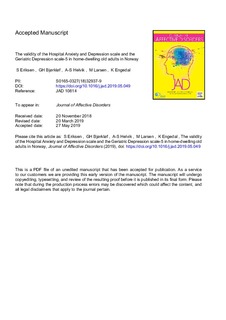| dc.contributor.author | Eriksen, Siren | |
| dc.contributor.author | Bjørkløf, Guro Hanevold | |
| dc.contributor.author | Helvik, Anne-Sofie | |
| dc.contributor.author | Larsen, Marianne | |
| dc.contributor.author | Engedal, Knut Arne | |
| dc.date.accessioned | 2019-06-20T08:59:17Z | |
| dc.date.available | 2019-06-20T08:59:17Z | |
| dc.date.created | 2019-05-29T09:03:12Z | |
| dc.date.issued | 2019 | |
| dc.identifier.citation | Journal of Affective Disorders.2019, 256,380-385 | nb_NO |
| dc.identifier.issn | 0165-0327 | |
| dc.identifier.uri | http://hdl.handle.net/11250/2601505 | |
| dc.description.abstract | Background
Little is known about the validity of the Norwegian versions of the Geriatric Depression Scale-5 (GDS-5) and the Hospital Anxiety and Depression Scale-D (HADS-D). The aim of this study was therefor to validate the two assessment tools in a population of home-dwelling persons of 60 years of age and above.
Methods
A sample of 194 home-dwelling old adults with and without depressive symptoms were recruited. The participants were examined for depressive symptoms (GDS-5, HADS-D) and cognitive impairment. Sociodemographic information was collected. The participants underwent a blinded diagnostic evaluation for a depressive episode according to the diagnostic criteria of ICD-10.
Results
In all, 56 (28.9%) participants fulfilled criteria for a depressive episode according to ICD-10. The Receiver Operating Characteristics analyses of HAD-D and GDS-5 using the diagnostic criteria of ICD-10 for depression as gold standard was performed. For GDS-5 the Areal under the Curve was 0.81 and for HAD-D 0.75. The cut-off points of the measures that produced the highest accuracies were ≥2 for GDS-5 with a sensitivity of 73.2% and a specificity of 73.2% and ≥4 for HADS-D with a sensitivity of 70.3% and a specificity of 69.6%.
Limitations
A larger sample would have given the opportunity for analyzing home dwelling old adults with and without home health care separately. The participants were talked through the self-filling questionnaires. The procedure could have influenced the participants’ answers.
Conclusion
GDS-5 and HADS-D are useful screening tools for old adults, but only fairly good to identify depression according to criteria of ICD-10. | nb_NO |
| dc.language.iso | eng | nb_NO |
| dc.publisher | Elsevier | nb_NO |
| dc.rights | Attribution-NonCommercial-NoDerivatives 4.0 Internasjonal | * |
| dc.rights.uri | http://creativecommons.org/licenses/by-nc-nd/4.0/deed.no | * |
| dc.title | The validity of the Hospital Anxiety and Depression scale and the Geriatric Depression scale-5 in home-dwelling old adults in Norway | nb_NO |
| dc.type | Journal article | nb_NO |
| dc.type | Peer reviewed | nb_NO |
| dc.source.pagenumber | 380-385 | nb_NO |
| dc.source.volume | 256 | nb_NO |
| dc.source.journal | Journal of Affective Disorders | nb_NO |
| dc.identifier.doi | 10.1016/j.jad.2019.05.049 | |
| dc.identifier.cristin | 1701109 | |
| dc.description.localcode | © 2019. This is the authors’ accepted and refereed manuscript to the article. Locked until 28.05.2020 due to copyright restrictions. This manuscript version is made available under the CC-BY-NC-ND 4.0 license http://creativecommons.org/licenses/by-nc-nd/4.0/ | nb_NO |
| cristin.unitcode | 194,65,20,0 | |
| cristin.unitname | Institutt for samfunnsmedisin og sykepleie | |
| cristin.ispublished | true | |
| cristin.qualitycode | 1 | |

